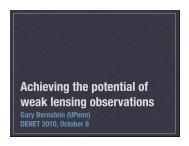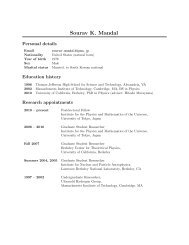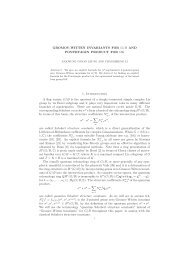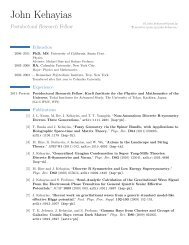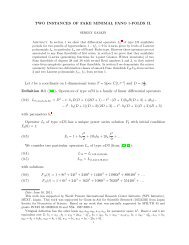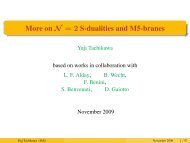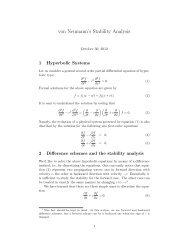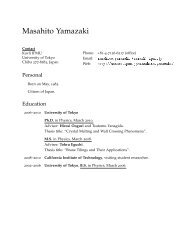STUDY SUMMARY - IPMU
STUDY SUMMARY - IPMU
STUDY SUMMARY - IPMU
Create successful ePaper yourself
Turn your PDF publications into a flip-book with our unique Google optimized e-Paper software.
<strong>SUMMARY</strong> REPORT<br />
WIDE FIELD FIBER-FED OPTICAL<br />
MULTI-OBJECT SPECTROMETER (WFMOS)<br />
primarily with, but not limited to, the project manager, project scientist, and instrument<br />
system engineer.<br />
• The project manager is responsible for delivering an instrument that meets the<br />
requirements on schedule and at cost. Responsibilities include communication with<br />
Gemini and JPL program management, coordination of the technical team, and managing<br />
resources. In this case, the instrument has a firm cost cap, so a critical feature of the<br />
program manager’s role is to anticipate any cost overruns and, if necessary, implement<br />
descopes in a timely manner. These actions must be communicated clearly to the PI and<br />
to Gemini if they affect any requirements from the OCDD Level 1 Requirements or<br />
Instrument Level.<br />
• The project scientist’s role is to provide the modeling and assessment necessary to<br />
ensure the instrument capability is consistent with the science objectives derived in the<br />
OCDD. In addition, he fulfills the role of providing a strong tie between the science and<br />
engineering team as the design and build of the instrument progresses. In this role, he is a<br />
key player in assessing trades that affect instrument performance and determining and<br />
quantifying the impact on the science objectives.<br />
• The system engineer reports to the project manager, leads the technical architecture of<br />
the instrument and makes sure the subsystem development is balanced with respect to<br />
technical risk and complexity. In addition, the system engineer is responsible for risk<br />
management. All of this requires a comprehensive and in-depth knowledge of the<br />
instrument development and interaction between subsystems so that system-level trades<br />
in design or approach can be made effectively. The formalization of these decisions is<br />
through the management of the Level 2 and Level 3 requirements. In addition, the system<br />
engineer is responsible working with the Subaru technical representative to obtain the<br />
telescope ICDs and requirements. Finally, the system engineer manages and enforces<br />
configuration control over all governing documents.<br />
7.2 Instrument Cost<br />
The key elements in cost management are accurate cost estimates, detailed cost tracking, and<br />
timely actions for cost control. The total estimated cost for the WFMOS instrument is $68.5M,<br />
which includes a baseline cost of $58.3M and $10.2M in reserves (20%). The reserves do not<br />
include the Gemini-held reserves of 15%. Table 7.2-1 shows the costs by partner and Table 7.2-2<br />
provides the costs by top-level WBS. The partner contracts held with Gemini include 15% reserves,<br />
which are included in the total cost column in table 7.2-1. Reserves above 15% are included<br />
in the JPL total cost to allow management of reserves across the project. The process used<br />
to estimate necessary reserves is presented in section 5.2 of the Management and Cost Volume<br />
and in section 7.5 below. Half of the instrument cost should meet the Gemini partner shares requirement<br />
as shown in Table 7.2-3. The project partners are comprised of the U.S., UK, and Brazil;<br />
half of the project costs are distributed to the partners as shown in Table 7.2-3.<br />
72



